Agile methods at a glance: Scrum, Kanban, OKRs & more
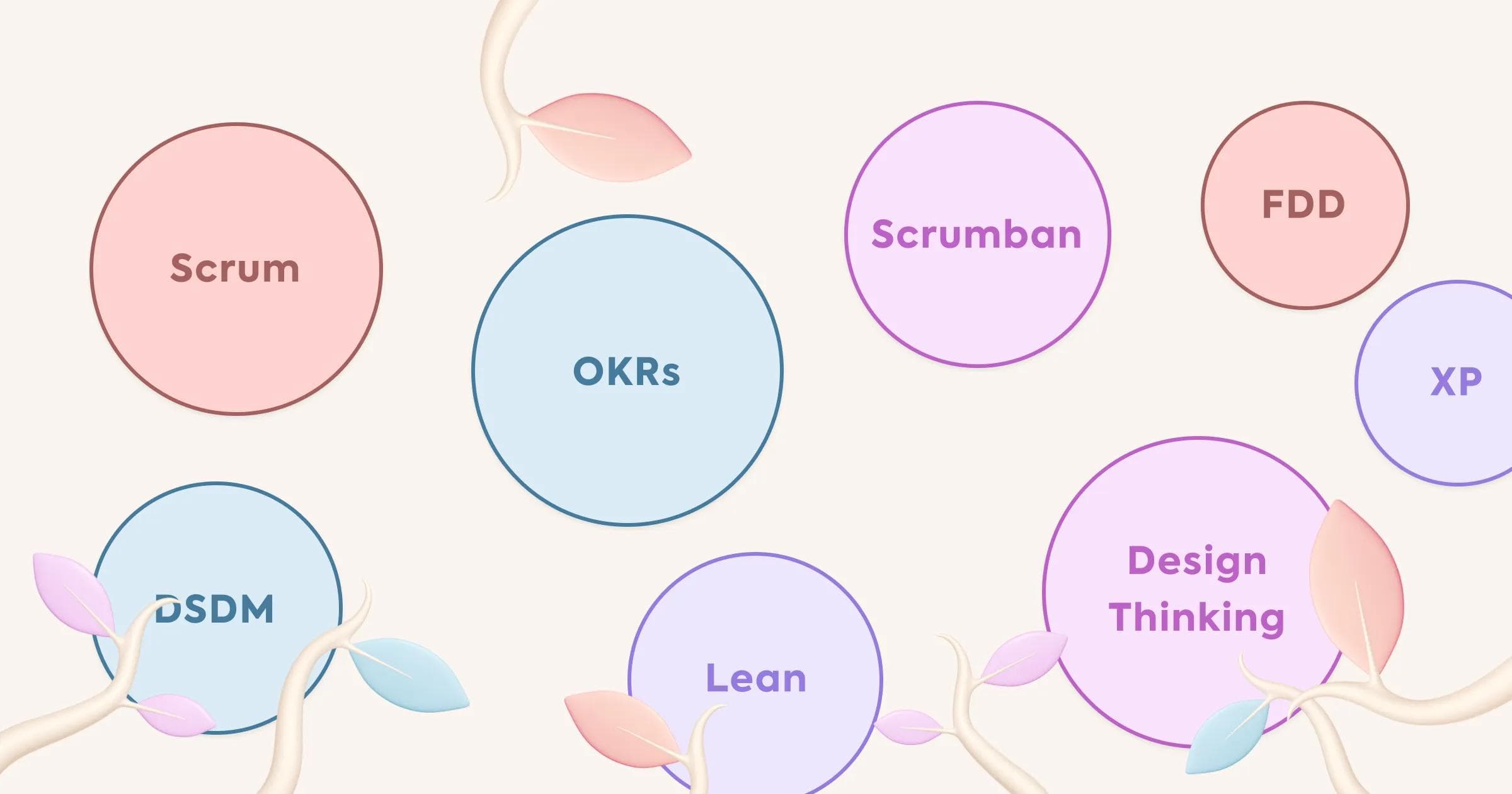
Companies want and need to become more agile to stay competitive – but not all of them actually succeed in putting the concept of agility into practice and applying agile methods correctly.
Often, companies fail because they don't know the difference between agile principles, techniques and methods – and what's more, they don't know which agile methods are best for driving their projects forward.
To make sure you don't feel the same way, we'll clear up some of the confusion in this article: We'll explain what agile methodology means, introduce you to ten agile frameworks in detail, and tell you how to choose the right agile methodologies for your company.
What to expect:
- What is agile project management?
- What are agile methods? Definition
- 10 agile methods outlined
- Why should companies use agile methods?
- How do I find the right agile methods for my company? 4 tips
- Conclusion: Get the most out of a mix of agile methodologies
- Agile methods – FAQ
What is agile project management?
Before we dive deeper into the different agile methodologies, it's worth taking a look at the terms “agility” and “agile working”.
Agility refers to a certain mindset that is focused on adapting quickly, flexibly and proactively to changes and challenges in everyday work.
Agile project management describes the way of working that results from this mindset and is based on flexibility, constant learning and adaptability. Work processes should be kept flexible enough at all times to be able to adapt to changing requirements. People and interactions take precedence over tools and processes. Customer satisfaction is the ultimate goal.
You can read more about what agile project management actually is and what advantages it has for companies in our blog.
Definition: What are agile methods?
Agile methods are, in a sense, the tools needed to organize teams and companies in an agile way. They contain rules as well as descriptions of processes that help to put the abstract principles of the Agile Manifesto into practice. The generic term “agile project management” is often used synonymously.
Agile methodologies are characterized by the fact that they all rely on self-organized agile teams, strive for continuous improvement, focus on high-quality products and only truly function with intensive communication. In addition, agile methodologies usually work cooperatively in small and focused teams as well as iteratively. This means that agile processes are repeated until the desired result is achieved. Customer feedback is actively incorporated right from the start.
Overall, agile methodologies are sets of rules for implementing the principles from the Agile Manifesto, but they rely much more on personal responsibility than on rigid specifications.
Agile methodologies vs. agile techniques
Agile methodologies should in no way be confused with agile techniques.
While agile methodology provides a basic structure for goal, strategy or project management, the term “agile techniques” refers to concrete practices and procedures for implementing agile values and principles. They help to actually make things like more flexibility, more personal responsibility and a more motivated team a reality.
Examples of agile techniques are:
- Task Boards (overview of current tasks, divided into to-do/in process/completed).
- Daily Standup Meetings (daily compact meetings on the status quo)
- Definition of Done (clear criteria when a task is considered done)
- User Story (describe requirements for the product from the customer's point of view)
- Burn-Down-Charts (visualization of project progress)
10 agile methods outlined
Overall, there are a variety of agile methods, most of which were once originally agile software development methodologies. After all, the concept of agile working originated in this industry. In the meantime, however, many of these methodologies can be transferred quite easily to other projects and used universally in almost every company.
But what exactly is behind Scrum, Kanban & Co? Let's take a closer look at that now.
Specifically, we will look at ten important agile methods:
- Scrum
- Kanban
- Scrumban
- Objectives and Key Results (OKRs)
- Lean
- Extreme Programming (XP)
- Design Thinking
- Feature-Driven Development (FDD)
- Dynamic System Development Method (DSDM)
- Spotify
1. Scrum
Scrum is probably the most widely used agile methodology. It can be applied for both product development and project management and follows an iterative approach: A Scrum team (max. 10 people) works in short development cycles of one to four weeks, so-called sprints, to complete a product or project. Whenever a sprint is over, the results are presented and used as input for the next sprint.
Within a Scrum team, there are three main roles: product owner, development team and Scrum master. The product owner prioritizes the pending tasks and considers in the product backlog what a product or solution might look like. The development team then takes over the implementation. The Scrum master is responsible for the entire process and coaches the team during the sprints.
How it works:
- At the beginning of a Scrum project there is always a vision, i.e. a rough idea of the project result or of a new product.
- Based on this vision, everything that the new product should have or be able to do is recorded in a user story.
- All the subtasks that need to be completed in order to implement the new product are then collected in the product backlog.
- In addition, a time frame is set for the entire project and all team members and experts are given a clear framework for the project process by the Scrum master.
- The individual tasks from the product backlog are then implemented bit by bit in sprints of one to four weeks.
- At the end of each sprint there is a detailed review in which the progress of the project is checked.
- During the sprints, a daily scrum of a maximum of 15 minutes takes place, in which the teams briefly report on the status quo.
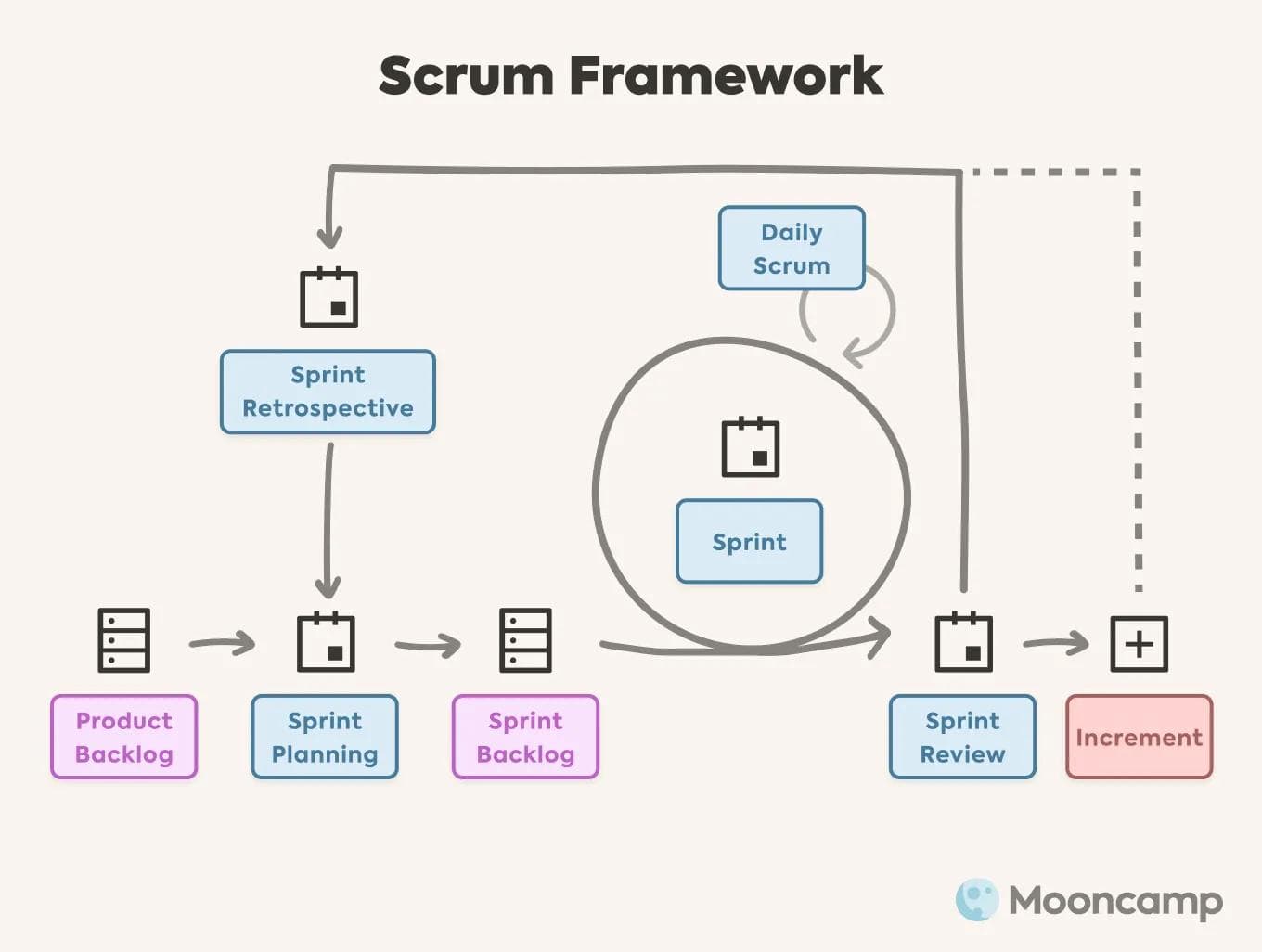
2. Kanban
Kanban is a straightforward agile methodology that is basically based on a Post-It system. With the help of the Kanban method, tasks and processes in companies can be clearly prepared and visually represented. This agile methodology is universally applicable in a wide variety of contexts.
How it works:
- Individual tasks are represented on a Kanban board by colored cards (often Post-Its) and arranged in columns. A classic board usually consists of three columns (so-called “swimlanes”): to-do, in process, and done. The process can also be represented in a more detailed way.
- Once a Kanban process is set up, each task in the project passes through the board according to the pull principle.
- This means that Kanban relies on the fact that all team members proactively “pull” pending tasks from the backlog into their own workspace.
- The board then shows at any time, in which processing status the tasks are. This allows bottlenecks to be visualized and identified more quickly.
- In most cases, a limit is also set as to how many tasks may be in the “in progress” status at the same time (so-called work-in-progress limit).
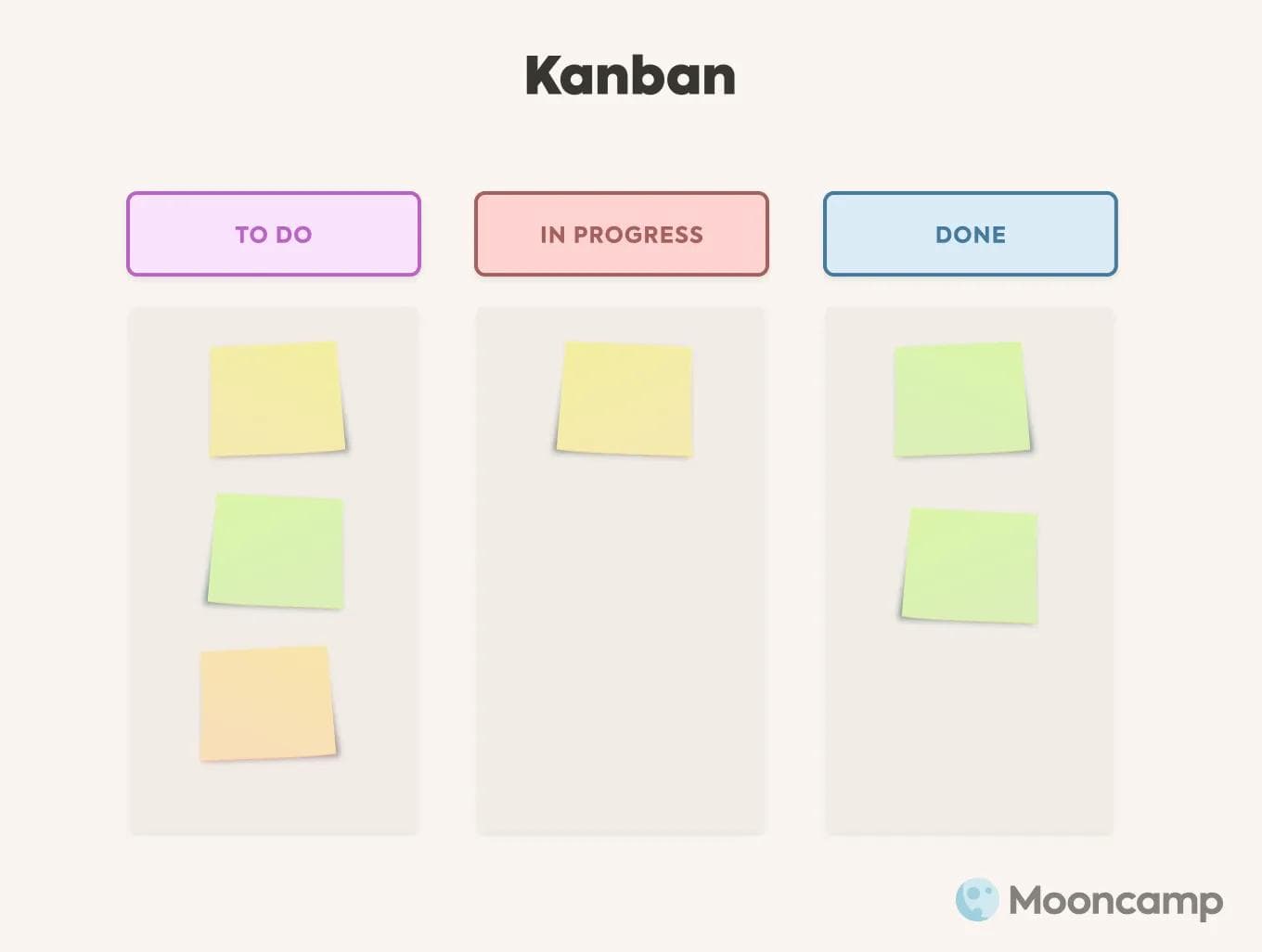
3. Scrumban
Agile methodologies can also be combined with each other. A popular example is Scrumban – a hybrid of Scrum and Kanban that combines the fixed structure of Scrum with the flexibility of Kanban.
How it works:
- In the Scrumban process, there is usually no team hierarchy, so there is no Scrum master either. The team manages itself.
- There is a backlog with tasks that need to be completed. The team members independently pull the tasks from the backlog into their own workspace.
- There they go through the different Kanban process phases. How many tasks can be in progress at the same time is also determined in advance here.
- Results are (unlike in Scrum) not only provided and controlled at the end of a sprint, but continuously.
4. Objectives and Key Results (OKRs)
Objectives and Key Results (OKRs) make companies more agile at a higher, strategic level – with the help of transparent, inspiring objectives that are defined across all levels, implemented independently by teams and monitored using quantitative key results.
How it works:
- Qualitative objectives are defined for the entire company and linked to 2 to 4 quantitative key results.
- This way, the company's vision and mission are translated into tangible goals for employees.
- The teams work independently in iterations of usually three months to implement the defined OKRs.
- Whether the goals have been achieved is checked in each case using the defined key results.
- By always defining OKRs on a quarterly basis and regularly monitoring them, it is possible to react quickly to changes and make readjustments if necessary.
Want to learn a bit more about OKRs? We have the right reading recommendation for you: On our blog we have also put together a complete guide to OKR, Agile & Scrum, where you can learn everything you need to know about the interplay between OKRs and Agile.
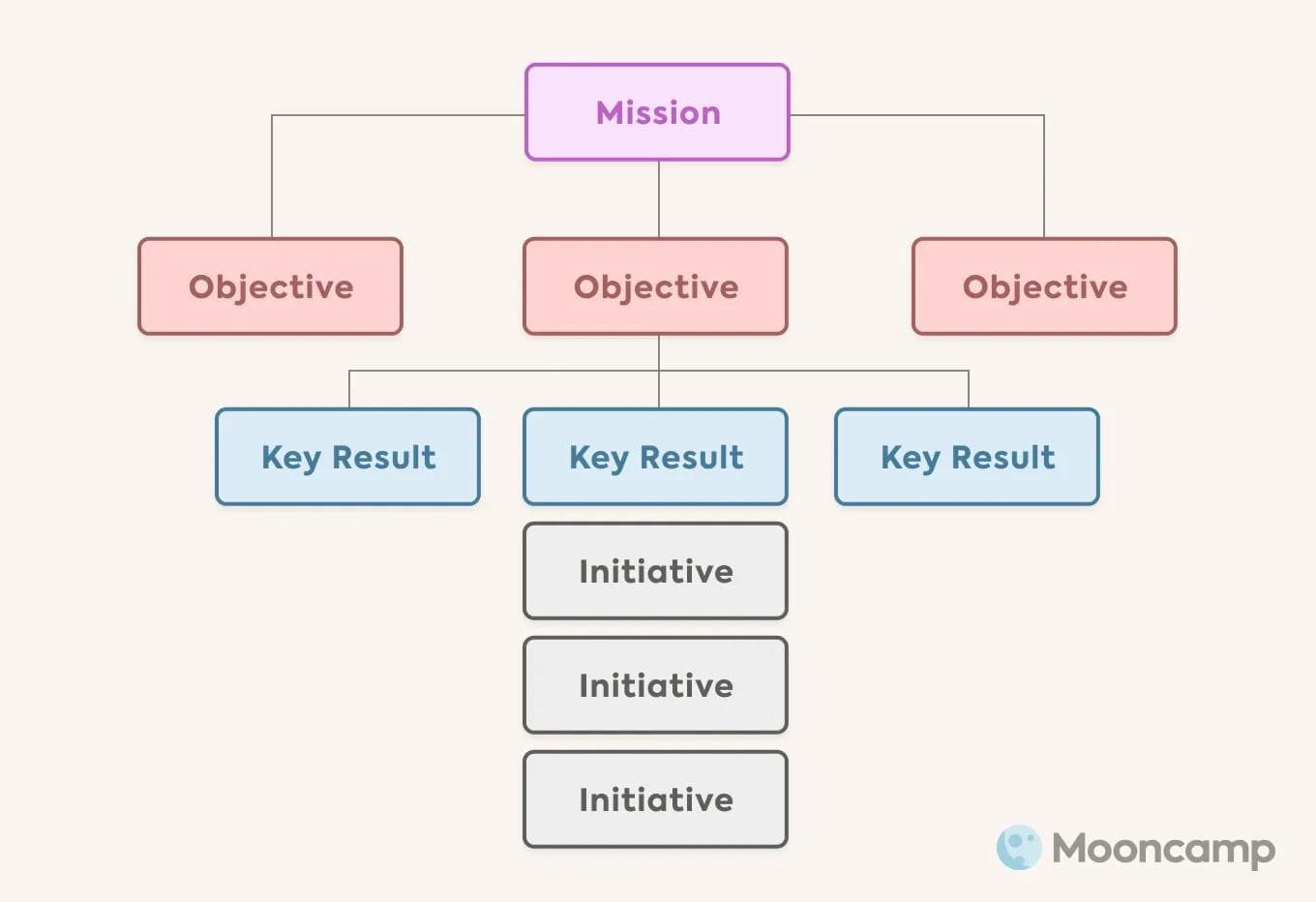
5. Lean
The Lean method allows projects to be reduced to the essentials and processes to be streamlined. The goal is to create value without waste. In other words, the maximum benefit for the customer should be achieved with the minimum possible input of personnel, time and money.
How it works: Lean management is less a methodology than a corporate philosophy. Two central aspects of lean are (1) customer focus and (2) cost reduction. Lean software development follows five principles:
- Adopt a customer perspective and identify concrete added values for customers
- Identify the entire process from start to finish (value stream)
- Create flow by eliminating activities that do not add value to the end product (avoid waste)
- Respond to customer needs (pull principle)
- Aim for perfection The first four steps are cycled through as often as necessary until at some point the “perfect state” is reached and the processes in the company are completely focused on optimally meeting the needs of the customer.
6. Extreme Programming (XP)
Extreme Programming (XP) is a method specifically tailored to the agile development of software. It focuses on flexible processes, rapid adaptability and very short development times. It also involves working in short, iterative cycles. Customer requirements are always the focus.
How it works: XP is based on values, principles and techniques. The following five values form the basis: communication, simplicity, feedback, courage and respect.
These principles link those five values to the techniques:
- Getting and acting on feedback immediately is a top priority.
- One should always strive for simplicity.
- Changes should never be made in large chunks, but always incrementally, in small steps.
- Customer requests and changes should be received positively.
- The quality of work should not suffer at any point in the process.
Work is problem-based and usually done in very short cycles of one day to one week.
Roles and tasks are clearly assigned: The customers are the focus and define the requirements. The developers respond to the customer's wishes and implement them. People from management make strategic decisions and analyze the progress of the project. They also coordinate communication between customers and developers. A coach, usually external, also provides methodological support to the team and ensures that everyone in the team knows and implements the XP guidelines.
7. Design Thinking
Design thinking focuses on creative problem solving and innovative ideas. So-called design sprints are used in many larger companies, such as Google, when it comes to finding ideas for new products or mastering challenges in an innovative way. Strictly speaking, design sprints are more of a workshop format than an agile method – nevertheless, they definitely belong on this list.
How it works: A design sprint usually lasts five days and is completed after just one iteration. In those five days, an interdisciplinary team goes through all six steps of the design thinking process:
- The problem is defined and understood.
- Customer priorities are analyzed and internalized.
- The conceptual framework is defined.
- Solutions are developed and sketched within that framework.
- Finally, the best ideas are modeled.
- These models are presented to customers as prototypes.
With the customer's feedback, design thinking comes full circle – further implementation then usually takes place with agile methodologies such as Scrum or Kanban.
8. Feature-Driven Development (FDD)
Feature-Driven Development (FDD) is an agile framework that focuses heavily on features and provides a lot of time for design and development. However, features in the FDD context are not necessarily product features in the usual sense – instead, they are more comparable to user stories in Scrum.
How it works: FDD is basically a five-step development process that is completely run through once, or multiple times if needed:
- Develop overall model
- Create feature list
- Plan by features
- Design by features
- Implement by features
- FDD is agile in the sense that the focus is clearly on the needs of the customer or end user, and working on a small scale on one feature at a time until all requirements for a product or project are met.
9. Dynamic System Development Method (DSDM)
The Dynamic System Development Method (DSDM) belongs to the first agile methods and was set up originally particularly for software development projects. The method works iteratively and is based on involving users in a project from the very beginning, letting teams work autonomously, providing regular results and reports on the status quo, conducting continuous tests and working closely together within the development teams.
How it works: When working according to the DSDM method, one usually goes through seven phases:
- Pre-project (set vision and goals)
- Feasibility (check if goals can actually be achieved)
- Foundations (determine solutions and methods)
- Exploration (set priorities)
- Development (incremental product development)
- Implementation (implement each iteration of the project/product)
- Follow-up (evaluate benefits)
10. Spotify
The Spotify model originated in Sweden and was developed by the music service of the same name. It can be used to organize entire companies or divisions.
How it works:
- A large team is divided into many smaller, interdisciplinary units – so-called squads, which in turn are part of a tribe.
- In addition, employees are organized by subject and function through chapters.
- This means that employees have a professional home in their chapter (corresponds to the marketing department, for example) while they go about their daily work and work in squads on various projects in an interdisciplinary manner.
- In addition, the Spotify method provides space for voluntary communities, so-called guilds, in which employees can stay in touch on topics of their choice.

Why should companies use agile methods?
As you can see, there are numerous ways to become more agile in everyday work. But why do we need these models at all? The answer is simple: Trends are evolving faster and faster these days, unforeseen changes are the rule rather than the exception, and adaptability is an absolute prerequisite for organizations to stay on the cutting edge.
What's more, agile project management means working together towards a goal, pursuing a vision – and finally putting the focus back on what really matters: the needs of the customers.
How do I find the right agile methods for my company? 4 tips
You might now be asking yourself how to find the right agile methodologies for you and your business. Be careful: Not every method is equally well suited for every purpose. Agile methods do not fit into every environment and not every task necessarily needs to be worked on in a team.
Agile methods are particularly useful when dealing with complex environments and tasks. The so-called Stacey Matrix can help you classify your project: If you can neither precisely define the requirements for the implementation of a project, nor know the exact path to the solution, agile methods will most likely get you where you want to go.
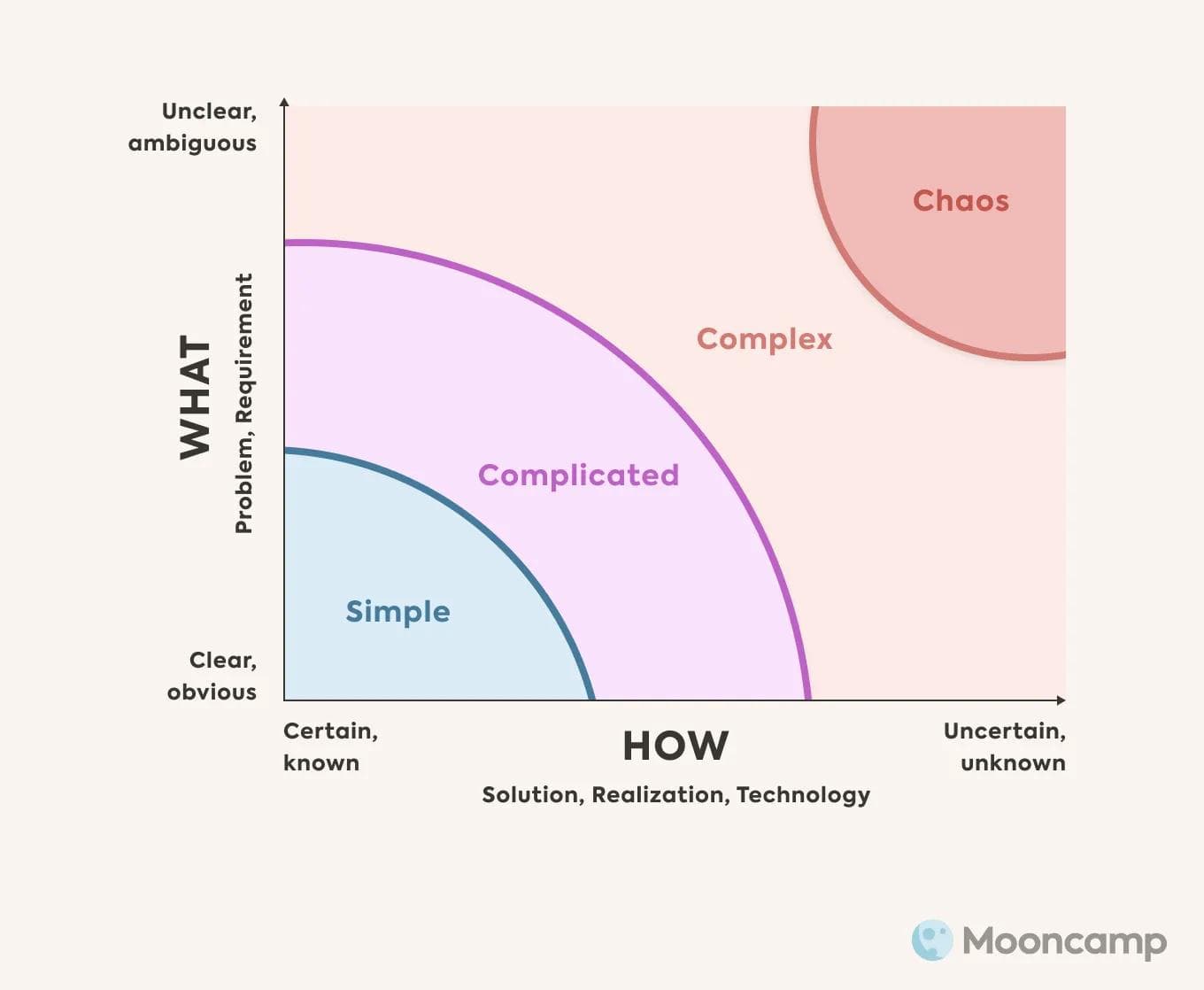
This means that agile methods are not a magic bullet.
In product development, marketing, strategic projects and resource planning, for example, agile work can be good – whereas in areas with routine tasks such as purchasing, customer support or accounting, agile methods are often less suitable.
Basically, you should critically question a few points before you start working in an agile way – and not just blindly follow the trends.
1. Check your vision, mission and company values.
As a first step, ask yourself whether your corporate culture is even designed for agile project management. Does the error culture you have established for your team fit with the philosophy of continuous learning? Is open feedback practiced? What does your leadership style currently look like? Do you give your employees enough freedom to work independently and organize themselves? Only if your mindset and corporate culture fit, you can successfully work agile in the long run.
2. Ask yourself what problem you want to solve.
To decide which agile method you want to work with, you should know what exactly you expect from it. What problem do you want to solve? And how complex is the problem? Agile methodology works best when it is the solution to a specific problem and not just implemented as an end in itself.
3. Understand the requirements.
Not every model fits every type of project and work. Therefore, take a very close look at the context in which you want to implement agile methodologies. What do your customers want? What are the requirements? Can tasks be planned autonomously or, as in the service area, are they constantly brought to you from the outside? In which phase of the commercial product life cycle is the product? Do you need to develop something new or optimize existing processes? Only when you know the requirements in detail can you really determine which agile approaches fit them.
4. Keep your eye on the ball, nobody's perfect.
Once you've decided on one or more agile methodologies, it's important to stick with them and trust the process – even if not everything runs smoothly at the beginning. At their core, all agile methodologies are based on the idea of continuous improvement. This means that even after a bumpy start, you can count on things getting better and better by continuously reflecting on your progress and optimizing the collaboration piece by piece.
Conclusion: Get the most out of a mix of agile methodologies
The bottom line is that agile methodology is versatile, flexible and mostly easy to apply. Accordingly, it is becoming more and more prevalent in the working world. The truth about agile methodology is also: There is no such thing as the one ideal framework.
The optimal solution for you and your business lies somewhere in the golden mean – between Scrum and Kanban, Design Thinking and Lean, OKRs and Scrum. The art of working with agile methodology is to find the right method at the right time for the right purpose – and to anchor the agile mindset deep into the DNA of your company.
Agile methods – FAQ
What are different agile methodologies?
There are many different agile methods. Some examples are Scrum, Kanban, OKRs, Lean, Design Thinking and Extreme Programming.
Which agile methodology is best?
Which agile methodology is right for your organization depends on what you want to get out of using agile methodology and what kind of projects you want to implement with it. Sometimes a combination of two agile methods, for example Scrum and OKRs, can also be the right choice.
What does it mean to be agile?
For companies, being agile means being able to react quickly, flexibly and proactively to changes in everyday work and to focus on the customer's competitive advantage. It also means continuous learning and relying on self-organized teams.
When does agile working make sense?
Agile working makes sense whenever you as a company are confronted with complex requirements or operate in a rapidly changing market.
Why is agile methodology important?
Agile practices can help companies stay competitive, plan and implement projects more efficiently, avoid mistakes, motivate employees and make processes more efficient.

